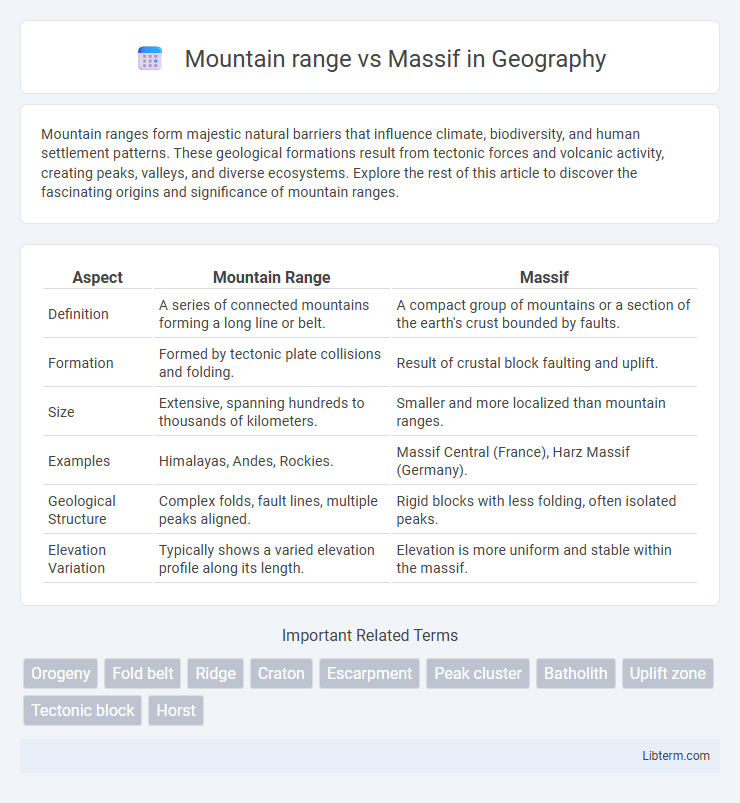Mountain ranges form majestic natural barriers that influence climate, biodiversity, and human settlement patterns. These geological formations result from tectonic forces and volcanic activity, creating peaks, valleys, and diverse ecosystems. Explore the rest of this article to discover the fascinating origins and significance of mountain ranges.
Table of Comparison
| Aspect | Mountain Range | Massif |
|---|---|---|
| Definition | A series of connected mountains forming a long line or belt. | A compact group of mountains or a section of the earth's crust bounded by faults. |
| Formation | Formed by tectonic plate collisions and folding. | Result of crustal block faulting and uplift. |
| Size | Extensive, spanning hundreds to thousands of kilometers. | Smaller and more localized than mountain ranges. |
| Examples | Himalayas, Andes, Rockies. | Massif Central (France), Harz Massif (Germany). |
| Geological Structure | Complex folds, fault lines, multiple peaks aligned. | Rigid blocks with less folding, often isolated peaks. |
| Elevation Variation | Typically shows a varied elevation profile along its length. | Elevation is more uniform and stable within the massif. |
Introduction to Mountain Ranges and Massifs
Mountain ranges consist of a series of connected mountains formed by tectonic forces, often extending over hundreds of kilometers and characterized by linear or arc-shaped alignments. Massifs are compact, elevated blocks of the Earth's crust, delineated by faults or flexures, typically featuring a single massive mountain or group of peaks. Understanding the distinction between mountain ranges and massifs is crucial for geological mapping and studying Earth's structural formations.
Defining Mountain Ranges
Mountain ranges consist of a series of connected mountains formed through tectonic plate movements and geological processes, often spanning hundreds of kilometers. They exhibit linear or arc-shaped formations with multiple peaks and valleys, creating distinct topographical features. In contrast, a massif is a compact group of mountains or a large, stable section of the Earth's crust, typically characterized by a single high elevation block rather than an extended chain.
Understanding Massifs
A massif is a compact group of mountains formed by tectonic plates pushing together, creating a distinct geological structure often characterized by uniform rock type and stability. Unlike expansive mountain ranges, which stretch over large areas and consist of multiple peaks and valleys, massifs are isolated blocks of crust that retain their shape despite surrounding erosion. Understanding massifs helps geologists identify stable regions within orogenic belts and assess their role in shaping regional landscapes.
Geological Formation: Range vs Massif
Mountain ranges consist of a series of connected mountains formed primarily through tectonic plate interactions, such as folding, faulting, and volcanic activity, resulting in elongated and linear geological structures. Massifs are large, compact blocks of crust that remain relatively stable and intact, often uplifted as a single unit without significant internal deformation. The key geological distinction lies in their formation processes: ranges arise from dynamic plate movements creating multiple peaks, while massifs represent coherent, rigid blocks resistant to intense tectonic distortion.
Structural Differences Between Mountain Ranges and Massifs
Mountain ranges consist of multiple connected peaks formed by tectonic plate movements, resulting in folded and faulted structures with varied elevations. Massifs are compact, stable blocks of the Earth's crust, often characterized by a single, large mountainous area with less pronounced folding or faulting. The key structural difference lies in the complexity and extent of deformation, with mountain ranges exhibiting extensive folding and faulting, while massifs maintain relatively rigid and coherent rock formations.
Notable Examples of Mountain Ranges
The Himalayas, Andes, and Rockies are notable examples of mountain ranges, characterized by a series of connected peaks extending over vast distances. Unlike a massif, which is a compact group of mountains formed from a single geological unit, mountain ranges consist of multiple massifs and separated peaks shaped by tectonic activity. These extensive ranges significantly influence climate patterns, biodiversity, and human habitation across continents.
Famous Massifs Around the World
A massif is a compact group of connected mountains formed by faulting or folding, distinguished from longer, linear mountain ranges like the Rockies or the Andes. Famous massifs include the Mont Blanc Massif in the Alps, known for its highest peak in Western Europe, and the Massif Central in France, characterized by ancient volcanic formations. These massifs serve as key geological structures with unique ecosystems and significant cultural and recreational importance worldwide.
Ecological Impact and Biodiversity
Mountain ranges, characterized by extensive linear formations such as the Himalayas, host diverse ecosystems due to their altitudinal gradients, supporting numerous endemic species and complex habitats. Massifs, like the Massif Central in France, are compact geological structures with unique microclimates that facilitate specialized flora and fauna, often resulting in high levels of localized biodiversity. The ecological impact of both involves climate regulation, water cycling, and habitat provision, but mountain ranges typically exhibit greater ecological connectivity, influencing broader biodiversity patterns across multiple regions.
Human Interaction and Cultural Significance
Mountain ranges shape human settlements by providing natural barriers that influence trade routes and cultural exchange, fostering distinct regional identities. Massifs often hold spiritual significance, serving as sacred sites or centers for traditional rituals in many indigenous cultures. Both formations inspire artistic expression and contribute to local economies through tourism and outdoor recreation activities.
Conclusion: Comparing Mountain Ranges and Massifs
Mountain ranges consist of a series of connected mountains formed by tectonic plate movements, whereas massifs are compact, elevated blocks of crust often bounded by faults and typically more geographically isolated. The structural complexity and geological formation processes distinguish mountain ranges from massifs, highlighting variations in size, orientation, and tectonic history. Understanding these differences aids in geological mapping, environmental studies, and resource management across diverse terrains.
Mountain range Infographic

 libterm.com
libterm.com